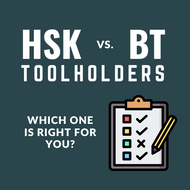HSK vs. BT Tool Holders: Which One is Right for You?
Published by Kortney on Nov 13th 2023
As a machinist, you understand that precision is everything. Every cut matters, every turn of the spindle counts. And the right tool holder can make all the difference in your operations. But with so many options available, it can be overwhelming to choose. Enter HSK and BT tool holders – two of the most popular types in the industry. In this article, we'll break down the differences between them and help you determine which one is best suited for your needs. From performance to compatibility to cost, we've got you covered.
What are HSK and BT tool holders?
Before we dive into which tool holder is best for you, let's first understand what HSK and BT tool holders are. HSK stands for hollow-shank taper, while BT stands for the Bridgeport taper. Simply put, these are two different types of tool holders used to connect cutting tools to a machine spindle.
The HSK tool holder was developed in the 1980s and is a newer and more modern design compared to the BT. It utilizes a hollow shank with a flange for tool retention and a taper for accurate positioning. The HSK holder provides high torque transmission, improved accuracy, and better rigidity. It is also known for its high-speed capabilities and low runout.
On the other hand, the BT tool holder is a traditional design that has been in use for over 80 years. It has a flat face with a bore for tool retention and a taper for accurate positioning. BT holders are designed for medium to heavy-duty cutting and are known for their good balance and stability.
Both HSK and BT tool holders have their unique advantages, and the choice depends on the specific application and machine being used. In the next section, we will compare the performance of HSK and BT tool holders to help you make an informed decision.,
Performance Comparison
When it comes to choosing between the HSK and BT tool holders, performance is a critical factor to consider. While both types of holders have their unique design features, they differ in performance capabilities.
The HSK tool holder is a newer design that offers superior grip force, accuracy, and repeatability. Its symmetrical structure reduces the centrifugal forces during high-speed machining, resulting in better stability and improved cutting performance. Additionally, the HSK holder's clamping system has a more uniform clamping force distribution, which reduces the risk of tool runout and increases tool life.
On the other hand, the BT tool holder has a traditional design that has been used for over 80 years. It is known for its good balance and stability, making it an ideal choice for medium to heavy-duty cutting operations. The flat face with a bore for tool retention and a taper for precise positioning offer excellent tool grip and accuracy.
When it comes to performance, the HSK and BT tool holders can both provide reliable and accurate performance for most applications. However, the HSK holder has the edge when it comes to high-speed machining and precision requirements. In summary, choosing between the HSK and BT tool holder depends on the specific application and machine being used. While the HSK holder offers superior grip force, accuracy, and repeatability, the BT holder is an excellent choice for medium to heavy-duty cutting operations.
Compatibility Comparison
When choosing between HSK and BT tool holders, compatibility with your machine is a crucial factor to consider. It's important to ensure that the holder you choose is compatible with the spindle taper of your machine. Both HSK and BT holders are commonly used in various types of drilling and milling machines. However, the HSK holder is more commonly found in high-speed machining centers, while the BT holder is preferred for medium to heavy-duty cutting operations.
HSK holders are designed to provide optimal performance with high-speed machines, making them compatible with machines that require higher rpms. On the other hand, BT holders are designed for machines that require less rpms and more torque, making them ideal for medium to heavy-duty cutting operations.
Overall, it's important to check the spindle taper of your machine before deciding on a tool holder. If your machine requires high-speed performance, an HSK holder is likely the better choice. However, if you're working with a medium to heavy-duty machine, a BT holder would be suitable.
Cost Comparison
When it comes to choosing between HSK and BT tool holders, another important factor to consider is the cost. HSK holders are generally more expensive than BT holders, and this can make a significant difference if you're on a tight budget. However, it's important to remember that the cost of the tool holder shouldn't be the only consideration. While an HSK holder may be more expensive, it may also offer higher performance and longer tool life, which could ultimately save you money in the long run. On the other hand, if you're working with a machine that doesn't require the high-speed performance of an HSK holder, a BT holder may be a more cost-effective choice.
Ultimately, the decision of whether to choose an HSK or BT tool holder will depend on a variety of factors, including the spindle taper of your machine, the type of work you're doing, and your budget. By carefully considering these factors and weighing the pros and cons of each option, you can make an informed decision about which tool holder is right for you.
We offer a cost effective way to tool up your machine whether you are looking for BT or HSK holders. Shop our large selection of HSK tool holders here or BT tool holders here. We feature both new and used tooling with a range to fit almost any budget. You can save even more when you utilize our tool buyback program - trade in your excess or obsolete tooling for a web account credit that can be spent directly on our website. Learn more about the tool buyback program here or by emailing us at toolbuyback@superiormachinetools.com.
Which one is right for you?
When it comes to choosing between HSK and BT tool holders, there is no one-size-fits-all answer. Ultimately, the decision should be based on the specific needs of your machine and the type of work you will be doing.
If you have a high-speed machine that requires precision and accuracy at high RPMs, an HSK holder may be the better choice. However, keep in mind that HSK holders can be more expensive and may require more maintenance. If you are working with a machine that doesn't require the high-speed performance of an HSK holder, a BT holder may be a more cost-effective choice. BT holders are also easier to install and typically require less maintenance.
When making your decision, consider the spindle taper of your machine and the type of work you will be doing. If you are on a tight budget, a BT holder may be the best option. However, if precision and speed are paramount, an HSK holder may be worth the investment.
In conclusion, choosing between HSK and BT tool holders ultimately comes down to your unique machining needs and budget. While HSK may offer better performance, it may not be compatible with your existing equipment or fit within your budget. BT tool holders may provide a cost-effective solution, but may not deliver the same level of precision as HSK. By considering factors such as spindle type, cutting tools, and machining requirements, you can make an informed decision on which tool holder is best for you. Remember, the right tool holder can make all the difference in your machining operations. As the renowned inventor Alexander Graham Bell once said, "Before anything else, preparation is the key to success." So take the time to choose the right tool holder and prepare for success in your machining operations.

